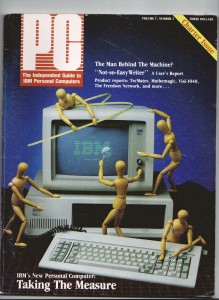It isn’t a newspaper, but to millions of computer enthusiasts, PC Magazine is an institution. It led the uprising of PC-empowered office workers against corporate IT departments in the 1980s and peaked at 1.2 million circulation in the 1990s. Issue sizes once ran to 500+ pages and the magazine supported a staff of more than 300 people. Its product reviews were considered the gold standard in the industry.
So the announcement this week that PC Magazine will exit the print market and go online-only was a turning point of sorts. With circulation down by half and an advertising base that has switched its budgets almost entirely online, the move makes sense. Expect to see more tech titles follow.
Longtime tech writer David Strom and I devote 14 minutes to a eulogy and look to the future in this podcast. Strom also has his own memorial here. Former PC Mag editor-in-chief Michael Miller also has a few thoughts.
Technology media has been a leading indicator of change in other media sectors. InfoWorld was the first major tech title to abandon print and many publishers have scaled back on size and frequency to keep their ink-on-paper operations viable. Most will tell you that they run print at break-even and make all their profits online. That was apparently the situation at PC Mag. Readers of tech publications are naturally more Internet-savvy than the general population, so the shift to the Internet was evident in the tech market several years ago. Look to that market as a leading indicator of where the media in general is going.
Tough times for the Newspaper Guild are shifting the union’s strategy from organizing laborers to simply surviving. Membership is down about 17% since 1986 and 2,000 Guild members have left this year alone. In a telling move, the union recently cut back the frequency of its internal newspaper from monthly to bimonthly and moved more content online. “Right now the biggest thing you’re fighting is the overall sense of impending doom,” is the uplifting quote from new Guild President Bernard Lunzer.
It’s so bad that the Guild is now focused on helping its longtime adversaries survive. The union recently pitched in to help finance an acquisition and it has worked actively with some newspaper owners to arrange concessions that would keep the titles afloat. It’s also beginning to organize people outside of the newspaper industry, such as interpreters in California courts.
The industry’s shift to online distribution hasn’t helped the Guild. Fobes notes that “Much of its power came from its ability to seize up a paper by asking sister unions running presses to strike.” With fewer copies to print and presses to staff, that club isn’t as big as it once was.
The Associated Press will reduce it staff by 10% over the next year. The cutback of roughly 400 positions will be accomplished by attrition to the greatest degree possible, according to CEO Tom Curley, but layoffs may be necessary. The AP instituted a hiring freeze several weeks ago. The pain being felt by member newspapers has hit the AP hard and the situation has worsened as several large members have announced plans to drop the subscription service in order to save money.
Comments
This entry was posted on Friday, November 21st, 2008 at 8:18 am and is filed under Paywalls. You can follow any responses to this entry through the RSS 2.0 feed. Both comments and pings are currently closed.




[…] Learn to show respect. A blog can share all the bad moves you’ve made to the whole world. And wait ’til traditional media fades into the background and blogs become as influential as they are abroad. You’ve probably heard that several newspapers and magazines in the US have shut down print production and have gone exclusively…. […]
[…] Learn to show respect. A blog can share all the bad moves you’ve made to the whole world. And wait ’til traditional media fades into the background and blogs become as influential as they are abroad. You’ve probably heard that several newspapers and magazines in the US have shut down print production and have gone exclusively…. […]
[…] like PC Magazine, which raked in more than $100 million a year in ad revenue at one point, were completely out of the print business by 2009. A lot of publishers perished, but those that survived have converted to a lead gen […]